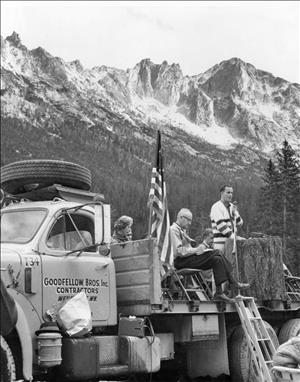On September 29, 1968, a rough draft of the North Cascades Highway -- then known as the North Cross-State Highway -- is dedicated at Rainy Pass in the North Cascade Mountains. "Rough draft" is the operative phrase here, as there are many miles of road that are unsuitable for most vehicles. But the stage is set for the highway's eventual completion, which will occur in September 1972. The highway, a portion of State Route 20, runs across Northern Washington from Skagit County to Okanogan County.
Happy Day
It was a highway 75 years in the making. In 1893 the Washington State Legislature appropriated $20,000 to build a road through the North Cascades, and work was done during the 1890s on a route named the Cascade Wagon Road, which would have taken the road across Cascade Pass and through Stehekin. This didn't get far. Work ended in 1899 and didn't resume in earnest until 1959, by which time a more northerly route had been chosen. Construction focused on a 50-plus-mile stretch that ran from Diablo Dam in Whatcom County to Early Winters Creek near Mazama in Okanogan County. After an arduous, adventurous nine years, a rough dirt road was finished through the mountains in 1968. Much of it wasn't yet suitable for cars, but it was still cause for celebration.
On Sunday, September 29, 1968, nearly 1,000 happy travelers came together at Rainy Pass by four-wheel-drive jeep, dune buggy, motorcycle, and horse to dedicate the highway. State officials had warned drivers that it would be a tough trek to the top and not to expect to average more than 10 m.p.h. on the road's long rugged stretches. Heeding the warning, travelers from both east and west of Rainy Pass got an early start into the hinterlands. But conditions were better than anticipated. The road was dry and firm. Joe Peterson, president of the Trailblazers Jeep Club in Bellingham, proudly reported that he managed an average of 11.2 m.p.h. on the 28-mile streak of "pioneer road" from Panther Creek to Rainy Pass, which the Bellingham Herald described as follows:
"[At Panther Creek] the pioneer road begins, slashing up the canyons of Ruby and Granite creeks to Rainy Pass, 4,860 feet high. In places the road is rough but graded; some sections are a thin bulldozer cut along steep mountainsides, and others a scrape through the alpine forest."
Where Are They?
Most people made it to the pass by 10:30, 90 minutes before ceremonies were to start. Men compared and contrasted their vehicles while women and children hiked in the warm sun, admiring scenery that most had never seen. The Winthrop Kiwanis served up burgers and chili; 84-year-old T. Tommy Thompson told tales of cutting the first trail through Rainy Pass in 1906; everything was going along great. Noon approached and organizers and spectators began to notice that many of the expected dignitaries hadn't arrived yet. The show couldn't start without them. Everyone waited. Then they waited some more.
Noon arrived. No dignitaries. The Twisp Boy Scouts dutifully presented the colors, and the 15-member Winthrop High School Band struck up the Star Spangled Banner. (Even the member on crutches joined in.) The anthem ended, the music faded. Folks looked around, murmured in puzzlement. Nothing was happening.
Finally at about 12:10 a helicopter arced out of the sky and landed in a whirl of dust. Out stepped U.S. Senator Warren Magnuson (1905-1989), resplendent in a crisp blue suit and raising a few snickers in the more casually attired crowd. Governor Dan Evans (1925-2024) arrived in a highway department vehicle about 15 minutes later, notably sans coat or tie. Mercifully, ceremonies finally kicked off.
Wrong Way
A round of speeches followed, by Magnuson, Congressman Tom Foley (1929-2013), and several others. Governor Evans concluded the speeches with one of his own. Noting that he was up for election later that fall, he promised that if reelected he'd see to it that the highway would be finished before the end of his next term in late 1972. Miss Washington Highways, Jeannine Marie Gill, then cut the ceremonial ribbon spread across the road with oversized scissors, and everyone who could eagerly posed for pictures.
The day capped off with a symbolic handshake that didn't go quite as planned. Two jeeps with a man on each hood jockeyed into position and edged toward each other. John Pierce of Bellingham, seated on one hood, represented the west; Les Holloway (or Hollaway) of Twisp, seated on the other, represented the east. Except they were going the wrong way. In the excitement of the moment Pierce ended up on the eastside jeep while Holloway found himself coming in from the west. "But who can tell in the pictures?" shrugged the Herald.
The highway was indeed finished in 1972, and was dedicated again, in a three-ceremony extravaganza on September 2 of that year.

